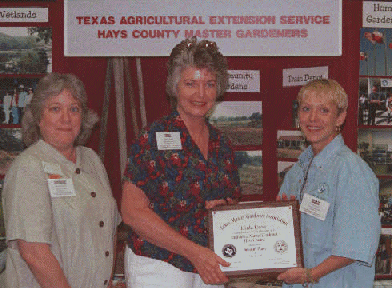

Gardening columnist earns prestigious award
Hays County Master Gardener Linda Keese (center) was recognized by the Texas Master Gardener Association as an Outstanding Individual Master Gardener for her 1997 volunteer efforts with the organization during a recent convention held in the Moody Gardens at Galveston. Presenting the plaque to Keese is Sharie Lanza, Chair of the Awards Committee. Looking on is Hays County Master Gardener Catherine Glesener. (photo by Paul Keese)
San Marcos Daily Record
Sunday, May 31, 1998
Gardening/Environmental Highlights 1989 -1999:
As with most people, my interests are tenfold running the gamut from gardener to preservationist to conservationist to materialistic consumer. Gardening however, has always been a constant, consuming interest I suppose I inherited from my father’s side of the family which included English and Irish ancestry.
He was the one who planted the family vegetable garden ringed with tall, absolutely beautiful purple bearded Iris each spring. He could grow whatever the favored plant of the season was with no trouble at all. Ours was always the house that people would come to and ring the door bell to ask if we were at all interested in selling, because of the landscaping.
Growing up in South American, first in El Centro, Colombia where I was born and then in Peru, I was constantly surrounded with family and friends who were interested in gardening. Living in a virtual rain forest in Columbia where orchids were commonplace in the boughs of trees and one had only to step outside to pick a banana or mango or coconut from a tree, I learned as a child to appreciate the beauty and scent of a flower and the sweet juiciness of a fresh fruit.
Living in Talara, Peru on an arid desert bordered on two sides with the Pacific Ocean made me very aware, even in my teenage years, of how fragile life was without drinking water. In Talara, it only rained once or twice a year. Our water was piped in from Piura over 100 miles away. If the water lines broke, which they constantly did, we were virtually without water for days at a time. Our gardens were extremely small. The golf courses were made of sand.
In the family travels across the United States after I married, we were constantly ‘putting in new gardens’ in different parts of the country. Learning what would thrive rather than survive in each location would put our research ability to the test with each move.
What kept appearing in the landscapes we researched were the old garden roses, passing the test of time. From New Jersey to Colorado, California to Texas, roses that were cherished and transported to this country by immigrants far and wide were surviving and thriving in ditches and corners of gardens across the country. They became my interest and my passion after attending my very first Texas Rose Rustle when we retired to San Marcos in 1989.
Since then, I have spent many a day slugging through some part of Texas’ wild country in order to obtain cuttings of rare and exotic roses, true survivors of the old west. Valued for their ability to survive in spite of drought, extreme heat and pests of every size and shape, they mark space and time in the history of a developing nation of immigrants who brought a living piece of home with them to the new country.
A garden should showcase the plants that grow well in any given area, both native and naturalized. By growing the old roses that have survived along with native plants, herbs and bulbs, each benefits the other. Take a look at the catalog and read the descriptions of the roses that I found in and around San Marcos. I’ve tried to include a bit of history with each one.
| Home | Rose Catalog | Rose Index | Odering Info | Rose Care |
© 1997-2007 Linda's Antique Roses
All rights reserved.
All images contained is this site may not be used, reproduced or distributed without prior written consent from Linda's Antique Roses.
Any trademarks or copyrights remain the property of their respective owners.